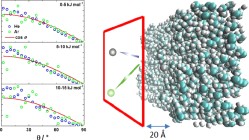
Sum-frequency Generation on Graphene: The non-linear laser spectroscopy technique of vibrational sum-frequency generation is surface-selective, making it an ideal tool to investigate graphene and its derivatives, as graphene inherently is one (or two?) large surface(s). We have succesfully employed SFG to detect trace impurities of PMMA from polymer-transferred graphene, Ref. 21. We have furthermore functionalised graphene with phenyl rings (can't see the wood for the trees) and detected these phenyl groups (trees) and even quantified the surface coverage (up to 7%), see Ref. 24. More recently, we have identified the ortho- and para-hydrogenation of graphene by spectroscopically anlaysing the C-H stretches in hydrogenated graphene (Ref. 28), and we are currently studying the ultra-fast energy transfer through those bonds. I must mention Drs Rob Lindsay and Andrew Thomas from UoM who - together with their own groups - were instrumental in developing the SFG spectrometer. More here...
